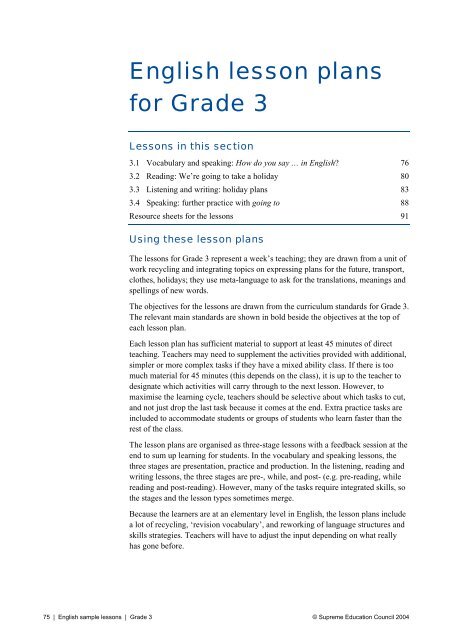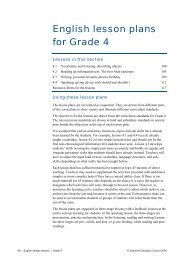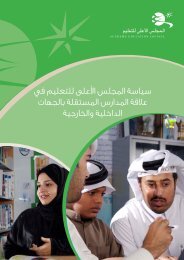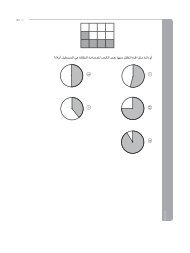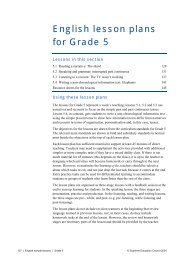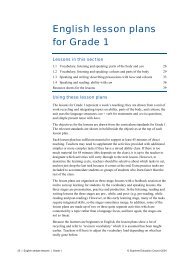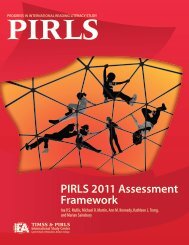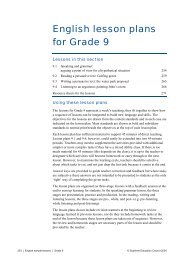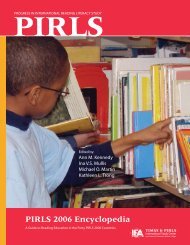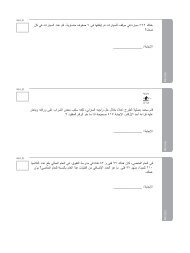English lesson plans for Grade 3
English lesson plans for Grade 3
English lesson plans for Grade 3
You also want an ePaper? Increase the reach of your titles
YUMPU automatically turns print PDFs into web optimized ePapers that Google loves.
<strong>English</strong> <strong>lesson</strong> <strong>plans</strong><strong>for</strong> <strong>Grade</strong> 3Lessons in this section3.1 Vocabulary and speaking: How do you say … in <strong>English</strong>? 763.2 Reading: We’re going to take a holiday 803.3 Listening and writing: holiday <strong>plans</strong> 833.4 Speaking: further practice with going to 88Resource sheets <strong>for</strong> the <strong>lesson</strong>s 91Using these <strong>lesson</strong> <strong>plans</strong>The <strong>lesson</strong>s <strong>for</strong> <strong>Grade</strong> 3 represent a week’s teaching; they are drawn from a unit ofwork recycling and integrating topics on expressing <strong>plans</strong> <strong>for</strong> the future, transport,clothes, holidays; they use meta-language to ask <strong>for</strong> the translations, meanings andspellings of new words.The objectives <strong>for</strong> the <strong>lesson</strong>s are drawn from the curriculum standards <strong>for</strong> <strong>Grade</strong> 3.The relevant main standards are shown in bold beside the objectives at the top ofeach <strong>lesson</strong> plan.Each <strong>lesson</strong> plan has sufficient material to support at least 45 minutes of directteaching. Teachers may need to supplement the activities provided with additional,simpler or more complex tasks if they have a mixed ability class. If there is toomuch material <strong>for</strong> 45 minutes (this depends on the class), it is up to the teacher todesignate which activities will carry through to the next <strong>lesson</strong>. However, tomaximise the learning cycle, teachers should be selective about which tasks to cut,and not just drop the last task because it comes at the end. Extra practice tasks areincluded to accommodate students or groups of students who learn faster than therest of the class.The <strong>lesson</strong> <strong>plans</strong> are organised as three-stage <strong>lesson</strong>s with a feedback session at theend to sum up learning <strong>for</strong> students. In the vocabulary and speaking <strong>lesson</strong>s, thethree stages are presentation, practice and production. In the listening, reading andwriting <strong>lesson</strong>s, the three stages are pre-, while, and post- (e.g. pre-reading, whilereading and post-reading). However, many of the tasks require integrated skills, sothe stages and the <strong>lesson</strong> types sometimes merge.Because the learners are at an elementary level in <strong>English</strong>, the <strong>lesson</strong> <strong>plans</strong> includea lot of recycling, ‘revision vocabulary’, and reworking of language structures andskills strategies. Teachers will have to adjust the input depending on what reallyhas gone be<strong>for</strong>e.75 | <strong>English</strong> sample <strong>lesson</strong>s | <strong>Grade</strong> 3 © Supreme Education Council 2004
3.1Vocabulary and speaking:How do you say … in <strong>English</strong>?Objectives<strong>Grade</strong> 3 curriculumstandards 1.2, 5.3,6.11, 8.4Presentation /PracticeVocabularycheap, expensivefast, slowheavy, lightspecial, normalRevision vocabularya busa cara bikea traina planea balloon• Use meta-language to ask <strong>for</strong> spellings and meanings of new words.• Learn and use adjectives to describe <strong>for</strong>ms of transport.• Practise asking wh-type and yes/no questions.• Read and respond to in<strong>for</strong>mation in word cards.Model questionsDraw the different <strong>for</strong>ms of transport (bus, train, bike, plane, car, balloon) on theboard one at a time and, as you draw, ask students the following model questions.Model question:Model question:What and whereHow do you say this in <strong>English</strong>?How do you spell it?As students spell the names of the <strong>for</strong>ms of transport, write them on the board,placing them randomly. Put a circle or oval around each one.a busa planea traina cara bikea balloonWhen you have all six, point to them at random and get the students to repeat thenames. Then, as you point and they repeat, begin to erase the words, leaving onlythe circle. Point to the empty circle and make students remember what was there.Continue to do this until you have six empty circles. Then get students to come tothe board and write in the words again or tell you what to write.Arabic word-cue drillWrite out the eight new adjectives (cheap, expensive, fast, slow, heavy, light,special, normal) in Arabic on separate cue cards. Hold the first card up and ask themodel question.Model question:How do you say … in <strong>English</strong>?Get students to ask you the same model question through choral and individualrepetition.76 | <strong>English</strong> sample <strong>lesson</strong>s | <strong>Grade</strong> 3 © Supreme Education Council 2004
Tell them the <strong>English</strong> word. Then get students to ask you the following modelquestion.Model question:How do you spell it?Give them the spelling as you write it on the board.Go through all eight Arabic words in this way, with students asking <strong>for</strong> the word in<strong>English</strong> and you giving it to them, until you have all eight adjectives in <strong>English</strong> onthe board.MatchingTo check understanding, distribute the Arabic word cue cards among the class andget students to come up and stick them next to the <strong>English</strong> equivalent on the board.Erase the <strong>English</strong> words again, one at a time, and get students to practise in pairs,asking and answeringA: How do you say … in <strong>English</strong>?B: A train.A: How do you spell it?B: t-r-a-i-nPelmanismPut students into groups of four. Give each group a set of cards. In each set, have16 one-word cards: the eight adjectives in <strong>English</strong> and the eight equivalents inArabic. The set should be on cardboard thick enough not to be see-through whenplaced face-down on the table. Get students to gather round one group as you showthem how to play the game. The cards are shuffled and placed face down in aregular pattern on the table. Students take it in turns to turn over two cards, face upon the table (not picked up into their hand). They must turn over the cards in thisway so that everyone in the group can see what and where the cards are. If theymatch – the Arabic adjective with the <strong>English</strong> adjective (their direct meanings, nottheir opposites) – then the one who has turned them over has to say the <strong>English</strong>adjective aloud and may then keep the pair. If the cards don’t match, the studentmust turn them back, face down, exactly where they came from. The player withthe most cards at the end of the game wins.True/false repetition drillMake statements about the means of transport, using the eight adjectives. If thestatement is true, tell the students they must repeat it. If the statement is not true,tell the students they must stay silent.Teacher saysTrains are heavy.Balloons are light.Buses are light.Planes are fast.Buses are cheap.Planes are cheap.Cars are normal.Balloons are special.Bikes are slow.Students dorepeatrepeatstay silentrepeatrepeatstay silentrepeatrepeatrepeat77 | <strong>English</strong> sample <strong>lesson</strong>s | <strong>Grade</strong> 3 © Supreme Education Council 2004
Guessing gameGet students to choose one of the <strong>for</strong>ms of transport and to write it on a small pieceof paper. Tell students not to show anyone else; it’s a secret. Choose a <strong>for</strong>m oftransport yourself and write it on a scrap of paper. Guard it with your hand to showit’s a secret. Ask students to guess which <strong>for</strong>m of transport you’ve chosen. Tellthem to ask questions to find out what it is and that all you can say is yes or no.Student: Is it cheap?Teacher: No.Student: Is it heavy?Teacher: No.Student: Is it special?Teacher: Yes.Student: Is it a balloon?Teacher: Yes!ProductionThe student who guesses correctly then comes to the front with their scrap of paperand the game starts again. Once students have guessed two or three in this way, getthem to play the game in groups of four, to generate more question-asking practice.Shared writingDraw an outline of a hot-air balloon on the board, and write the following sentencebelow it.I want to go in a hot-air balloon.Get students to read this sentence aloud. Ask them why. Elicit in Arabic some oftheir ideas.It’s special.It’s exciting.Get them to work in pairs and come up with as many reasons as possible – inArabic – <strong>for</strong> why they want to go in a hot-air balloon. When every pair has at leastthree ideas, ask them to tell you their ideas. For each idea they offer, get them topractise asking you the following model question.Model question:How do you say … in <strong>English</strong>?Tell them how their idea translates into simple <strong>English</strong>, get them to repeat it, andthen write it up on the board, around the balloon.It’s fun.You can gohigh in thesky.It’s a bit dangerous.It’ssmooth.It’s special.You can see the clouds.It’ssilent.You can fly.I want to go in a hot air balloon.It’s exciting.It floats.Everythinglooks smallbelow.78 | <strong>English</strong> sample <strong>lesson</strong>s | <strong>Grade</strong> 3 © Supreme Education Council 2004
FeedbackIn turn, point to the sentences they have created with you and get the student whoseidea it was to read it aloud, or to read key words, according to their ability.Summary <strong>for</strong> studentsIn ArabicToday you learned how to ask <strong>for</strong> a word in <strong>English</strong> when you don’t know it. Youalso learned how to ask <strong>for</strong> the spelling. What were those two questions again?Every time you need to know a word in <strong>English</strong>, how to say it or how to write it,use one of those questions. It’s important to ask, and start collecting your personalwords – words you are interested in and words which help you say and write whatyou want to say in <strong>English</strong> more naturally and more clearly.79 | <strong>English</strong> sample <strong>lesson</strong>s | <strong>Grade</strong> 3 © Supreme Education Council 2004
3.2Reading: We’re going totake a holidayObjectives<strong>Grade</strong> 3 curriculumstandards 8.7, 7.4, 1.3,6.7, 10.1Pre-readingResourcesWorksheet 3.2aVocabularya holiday(to) packclothesVocabulary revisionJuneJulyAugustthe worlda planea cara balloonsome chocolateWhile readingResourcesWorksheets 3.2a and3.2b• Read and respond to <strong>plans</strong> with going to.• Read aloud with acceptable pronunciation and emphasis.• Collect key words from reading.• Use present continuous to talk about the future and become aware of going to<strong>for</strong> the future.• Complete simple sentences based on reading.Arabic word-cue drillRevise vocabulary (June, July, August, the world, a plane, a car, a balloon, somechocolate) and introduce new vocabulary (a holiday, (to) pack and clothes) byputting the Arabic translation of these words on cards. Hold up the cards and getthe students to ask each other <strong>for</strong> the <strong>English</strong> equivalent <strong>for</strong> the revision vocabularyand ask you <strong>for</strong> the <strong>English</strong> equivalent of the new vocabulary, using the modelquestion from <strong>lesson</strong> 3.1.• How do you say this in <strong>English</strong>?For the new words, get students to ask you the second model question from <strong>lesson</strong>3.1 to further rein<strong>for</strong>ce the meta-language.• How do you spell it?Multiple choice predictionTell students they are going to read a rhyme about going on a special holiday butbe<strong>for</strong>e reading they have to predict what happens. Give students worksheet 3.2a.Have them work in pairs. For each question, get them to read the three possibilities,and read aloud with them where necessary. Have them discuss the possibilities andthen choose one. Have them tick the box of their choice in pencil. Don’t correctany ‘wrong’ choices and encourage differences amongst pairs – sorting outdisagreements gives them a real purpose <strong>for</strong> reading. In their own words, withprompts and eliciting questions from you, and using the multiple choices they havechosen, get students to tell you what they think will happen in the poem.I think they’re going in August, by car, with some books and they’re comingback in one week.I think they’re going in June <strong>for</strong> two months, by plane with some chocolate.Guided readingHand out worksheet 3.2b and get students to read it all the way through tothemselves at their own pace. Prompt them to focus on the key vocabulary theystudied be<strong>for</strong>e and known words with known inflections like ‘go’ and ‘-ing’.80 | <strong>English</strong> sample <strong>lesson</strong>s | <strong>Grade</strong> 3 © Supreme Education Council 2004
Vocabulary in contextRemind them of their learned question, How do you say this in <strong>English</strong>? Help themturn it around so that they can also ask each other and you a further modelquestion.Model question:How do you say this in Arabic?Get them to repeat the question chorally and individually and then encourage themto point at unknown words in the text and ask you the question <strong>for</strong> real. Model thisby pointing to a word you know will be hard <strong>for</strong> them (e.g. ‘brilliant’) and askingthem, How do you say this word here? to get them to work out phonically how toread it aloud. Then ask them the following question.• How do you say ‘brilliant’ in Arabic?When no-one can answer, tell them to ask you the same question and then translate‘brilliant’ <strong>for</strong> them. Monitor, pointing to difficult words in the text and asking,How do you say this here? and How do you say this in Arabic? Focus on:• take a holiday• around the world• hot-air• that’s all• brilliant• never coming back.Multiple choice comprehensionGet students to check and correct their multiple choice predictions by ticking thechoices again on worksheet 3.2a in a different coloured pen or pencil.Post-readingResourcesWorksheet 3.2cReading aloudRead aloud <strong>for</strong> the students the poem on worksheet 3.2b with clear phrasing andemphasis (stress at the end of the line, stress on the main verb in the ‘going to’phrase). Have children point to the words in the text as you read. Then get them tojoin you in reading it aloud together. In pairs, have students read a verse each, orread alternate lines. Monitor and help individuals with fluency and pronunciation.Gap fill sentencesGive students worksheet 3.2c and tell them to finish the sentences in their ownwords. Encourage them to choose any month <strong>for</strong> the first sentence, any <strong>for</strong>m oftransport <strong>for</strong> the second sentence and any item of clothing, type of food orpossession <strong>for</strong> the third sentence. If they don’t know how to write the thing theywant to put in <strong>English</strong>, remind them of their questions How do you say … in<strong>English</strong>? How do you say this in <strong>English</strong>?, and How do you spell it?Guessing gameFill in worksheet 3.2c <strong>for</strong> yourself. Tell students they have to guess what you’vewritten <strong>for</strong> your three sentences but you can only say yes or no – just like theguessing game in the last <strong>lesson</strong> when they had to guess <strong>for</strong>ms of transport (<strong>lesson</strong> 3.1).Get them to guess the first sentence by asking questions like the following.Are you going in June?Are you going in January?81 | <strong>English</strong> sample <strong>lesson</strong>s | <strong>Grade</strong> 3 © Supreme Education Council 2004
Get them to guess the second sentence by asking questions like the following.Are you going by car?Are you going by balloon?Get them to guess the third sentence by asking questions like the following.Are you taking a camera?Are you taking a hat?Once students have guessed your three sentences, put them into groups of four andget them to take it in turns to guess each other’s sentences. Tell them to hold theirworksheets in such a way that no-one can see what they’ve written.FeedbackUse the guessing game to evaluate how well they can ask and answer yes/noquestions. Assess word order, ability to respond with short answers (Yes I am orNo I’m not), and their independence in asking questions.Give feedback on an individual level to students.Summary <strong>for</strong> studentsIn ArabicNow many of you can read a poem or a story on your own.You know how to ask about words you don’t understand or know in <strong>English</strong>. Youknow how to ask <strong>for</strong> the spelling of words.When you’re reading, you don’t have to know all the new words be<strong>for</strong>e you startreading. If you come across a difficult word, you can always ask your teacher whatthat word means and if the teacher isn’t around you can look it up in the dictionary.You also know how to ask yes/no questions in <strong>English</strong> to find out morein<strong>for</strong>mation.82 | <strong>English</strong> sample <strong>lesson</strong>s | <strong>Grade</strong> 3 © Supreme Education Council 2004
3.3Listening and writing:holiday <strong>plans</strong>Objectives<strong>Grade</strong> 3 curriculumstandards 1.2, 4.6, 6.7,10.3Pre-listeningResourcesWorksheet 3.2bVocabularya hotela rivera tentshortsa coata sweater• Use holiday vocabulary.• Listen to other people’s holiday <strong>plans</strong>.• Talk and write about own and others’ holiday <strong>plans</strong> using the going to future.Reading aloudGet students to read aloud the text on worksheet 3.2b with you.We’re going to take a holiday.We’re going to go in June.We’re going to go around the worldIn our hot-air balloon.We’re going to take some chocolate.That’s all we’re going to pack.We’re going to have a brilliant time.We’re never coming back!Pre-teach vocabularyTell students that they are going to continue to talk about and listen to holiday<strong>plans</strong>. Prepare Arabic word cue cards as translations of the new vocabulary(a hotel, a river, a tent, shorts, a coat, a sweater). Pre-teach the new words byshowing students the Arabic words and getting them to use the same metalanguagequestions they used <strong>for</strong> <strong>lesson</strong>s 3.1 and 3.2 to find out how to say andwrite them in <strong>English</strong>.• How do you say … in <strong>English</strong>?• How do you spell it?Rub out and rememberWrite the words on the board as the students ask you to spell them. Get the studentsto remember/read the words aloud with you as you point to them. Have studentsmatch the <strong>English</strong> words on the board with the Arabic word cue cards and stickthem up. Continue to point and get the students to remember/read the <strong>English</strong>words aloud to you, but start to erase the words or parts of the words, eventuallyleaving only the Arabic cue cards.When all the words have been reduced in this way, point to each rubbed out gap inturn and get students to remember and tell you what the missing <strong>English</strong> word ineach case is. Get students to come to the board and write in the <strong>English</strong> words. Ifthey can’t remember how to spell them, get students to ask the class.• How do you spell it?Open predictionTell students they are going to listen to the holiday <strong>plans</strong> of three children. Eachchild is going to go somewhere different, do something different, stay somewhere83 | <strong>English</strong> sample <strong>lesson</strong>s | <strong>Grade</strong> 3 © Supreme Education Council 2004
different, take different clothes. Their names are Samia, Fahed and Jafla. Putstudents in pairs. Put the following table on the board.SamiaFahedJaflaGo when? Stay where? Do what? Take what?Elicit a few suggestions from the students• When is Samia going to go on holiday? In January? In April? InSeptember?• Where is Fahed going to stay? In a hotel? In a house? With friends?• What is Jafla going to take? Her hat? Her sweater? Her camera?WhilelisteningResourcesWorksheet 3.3aTape script 3.3Put students in pairs and get them to predict the four things <strong>for</strong> each child. Havethem think about logical connections between place, activity and clothes (e.g.beach, swimming, shorts). Gather their suggestions and fill in the table on theboard with some of their ideas.Listening gridGive students worksheet 3.3a and put an enlarged version of it on the board or theOHP. Explain that the in<strong>for</strong>mation is all jumbled up, like a maze, and they have tolisten and then draw a line connecting the person with what their <strong>plans</strong> are. Havestudents use different colours (e.g. blue <strong>for</strong> Samia, yellow <strong>for</strong> Fahed, green <strong>for</strong>Jafla). Do the first one – Samia – together on the board while listening to the firstpart of tape 3.3.Samia November a tent take a boat shortsFahad January a house swim in the sea a coatJafla August a hotel walk in the hills a sweaterPost-listeningResourcesWorksheets 3.3a and3.3bHave students listen to the rest of the tape and trace the connections <strong>for</strong> Fahad andJafla. Play the tape several times until they’ve all got it. Then get them to comparethe real thing with the predictions they made be<strong>for</strong>e listening and see if anyonepredicted accurately.Model sentencesGet students to listen to you or the tape again, saying the following modelsentences:Model sentence:Model sentence:Model sentence:She’s going to stay in a hotel.He’s going to walk in the hills.Jafla’s going to take a sweater.Have students repeat these model sentences, chorally and individually. Write themup on the board and get students to copy them into their exercise books. Getstudents to read the sentences aloud once they’ve finished copying.84 | <strong>English</strong> sample <strong>lesson</strong>s | <strong>Grade</strong> 3 © Supreme Education Council 2004
Concept checkAsk students guided discovery questions to check that they understand going to is<strong>for</strong> talking about <strong>plans</strong> <strong>for</strong> the future. Use Arabic to avoid checking target languagewith the same target language.• Are Samia, Fahed and Jafla on holiday now? No• Are they going to be on holiday in the future? Yes• Are these their <strong>plans</strong>? Yes• What phrase do we use to make it future? Going to• What’s going to followed by? An action / a verbListening grid drillGet students to use worksheet 3.3a and the connecting lines they drew in whilelistening as cues to talk about Samia, Fahed and Jafla. Model the first one <strong>for</strong> them,pointing to the key words in the enlarged version of worksheet 3.3a on the boardand saying the following model sentences.Model sentences:Model sentences:Model sentences:Model sentences:Samia’s going to go in August.She’s going to stay in a hotel.She’s going to swim in the sea.She’s going to take her shorts.Get students to talk about all three of the children in this way, using a variety ofchoral and individual repetition. Then get students to practise in pairs – partner Atalking about Samia, partner B about Fahed, partner A about Jafla. Then get themto swap who they talk about.Trans<strong>for</strong>mation writingGive students worksheet 3.3b. Get them to read, individually, about Bader. Helpthem to find the ‘new in<strong>for</strong>mation’ with eliciting questions such as the following.• What’s he going to take with him? What else?• Where’s he going to stay?• What’s he going to eat?• What’s he going to look at?Tell students they are now going to take the sentences about Bader and turn theminto sentences about themselves. The holiday location is going to change to thebeach and they are going to write about a seaside holiday. Be<strong>for</strong>e writing, elicittheir ideas about the changes they will have to make when they write the sentencesout again. Show them that the underlined words are the ones they will have tochange. Tell them the rest they just copy. In Arabic, ask the following questions.• If it’s about you, what do we have to change ‘he’ to? I• What do we have to change ‘his to? My What about Bader’s? My• How many places can you see where to put ‘I’? Six• Where will you put ‘my’? Bader’s holiday plan, his walking shoes, his hat• If you’re going to the beach will you take your walking shoes? No• What will you take instead? Our shorts/ sandals• What about the hat? Yes• Are you going to walk or swim at the beach? Swim85 | <strong>English</strong> sample <strong>lesson</strong>s | <strong>Grade</strong> 3 © Supreme Education Council 2004
• What else are you going to do there? Play (on the beach) etc.• What are you going to eat? Meat or fish? Fish• What are you going to look at? The sea, the fish, the birds, the boats …FeedbackGet them to use the writing frame below the reading to trans<strong>for</strong>m the passage.Show them how to trace over the title and the first sentence to start with, and thento go on. Monitor and assist, provide ideas and help individual students. Encouragestudents to use their learned phrases How do you say [….] in <strong>English</strong>? and How doyou spell it? when they need help from you.Collect written work and analyse individual progress and needs.Summary <strong>for</strong> studentsIn ArabicToday you used going to to listen to, talk about, read about and write about holiday<strong>plans</strong>. Going to isn’t about the past or the present – it’s about the future. It’s aboutfuture <strong>plans</strong>.86 | <strong>English</strong> sample <strong>lesson</strong>s | <strong>Grade</strong> 3 © Supreme Education Council 2004
Tape script3.3For Samia:For Fahed:For Jafla:Samia’s going on holiday to the sea side. She’s going to go inAugust. She’s going to swim in the sea. She’s going to stay in anice hotel. She’s going to pack her shorts.Fahed’s going to have a holiday in November, at Eid. He’s goingto stay with some friends in their house. Every day he’s going towalk in the hills. It’s going to be cold, so he’s going to take hiscoat.Jafla’s going to go camping with her school. She’s going to go inJanuary. She’s going to stay in a tent. She’s going to go by boatdown a river. She’s not going to take a lot of clothes. She’s justgoing to take a sweater.87 | <strong>English</strong> sample <strong>lesson</strong>s | <strong>Grade</strong> 3 © Supreme Education Council 2004
3.4Speaking: further practicewith going toObjectives<strong>Grade</strong> 3 curriculumstandards 1.2, 6.7, 6.9,6.11PresentationVocabularyfirstthenafter that• Get further practice in talking about <strong>plans</strong> <strong>for</strong> the future with going to.• Use sequencing words with future <strong>plans</strong>: first, then, next, after that.• Ask wh-type questions with going to and sequence words.• Revise holiday, transport and clothes vocabulary.Noughts and crossesPut the following noughts and crosses grid on the board.1make a picnicgo to the beachhave a picnic2buy a ballgo to the parkplay football3pack a bagcatch a planehave a holiday4get uphave breakfastgo to school5go to the beacheat fishfind in a hotel6brush my teethgo to bedgo to sleep7take a sweatergo to the hillsgo <strong>for</strong> a walk8come homehave a drinkwatch TV9have a holidaystay with friendsswim in the seaGive students time to read all the phrases <strong>for</strong> themselves. Call on them to readdifferent boxes aloud. Help and correct their reading and check <strong>for</strong> understandingby asking How do you say that in Arabic?. Once they’ve understood all the cues,get students to use the cues to practise making sentences with going to: call anumber and get a student to use the in<strong>for</strong>mation in the square say three sentenceswith going to.Teacher saysNumber 2Student saysI’m going to buy a ball.I’m going to go to the park.I’m going to play football.In pairs, get students to do the same thing: one student calls a number, the otherstudent makes three sentences. Then they swap. Let them continue to practise untilthey’ve done all nine boxes. Monitor and correct <strong>for</strong> accuracy, especially mistakeslike I’m go to take a sweater and I going to take a sweater. Allow students to usethe present continuous <strong>for</strong> the future but if they don’t practise going to at all,remind them of the phrase and get them to do it again with going to.Remind students how to play noughts and crosses on the board; the aim is to getthree noughts or three crosses in a row (vertically, horizontally or diagonally; seepage 31).88 | <strong>English</strong> sample <strong>lesson</strong>s | <strong>Grade</strong> 3 © Supreme Education Council 2004
Put the class into two teams – The noughts and The crosses – and ask The noughtsto begin. To win a square, The noughts choose a square, say what number square itis, and then make three sentences using the word cues.Square number eight: I’m going to come home. I’m going to have a drink. I’mgoing to watch TV.If the three sentences are correct, a team member draws the noughts symbol overthe square and tells The crosses it’s now their turn. The first team with threesymbols in a row is the winner.Pre-teach vocabularyPre-teach the sequencing words first, then, after that. Explain in Arabic that theyare words <strong>for</strong> linking a series of events. It’s fine to say then …, then …, then …because then is the most common sequencing word but they can also use first at thebeginning and after that instead of then <strong>for</strong> variety.Get students to practise in pairs with the noughts and crosses grid, one calling anumber, the other saying three sentences with going to, but this time adding thesequencing words. first, then, after that.Student A saysNumber 2Student B saysFirst, I’m going to buy a ball.Then, I’m going to go to the park.After that, I’m going to play football.PracticeResourcesTeacher’s resource sheet3.4Put the class back into teams and get them to play a second round of noughts andcrosses with the words in the grid and the new sequencing words.Word cue drillPut the sequencing words on cue cards and use them to elicit wh-type questionswith sequencing words.Teacher saysfirstthenafter thatthenafter thatStudents sayWhat are you going to do first?What are you going to then?What are you going to do after that?What are you going to do then?What are you going to do after that?Get students to practise making the questions from the cue cards chorally,individually and in pairs.In<strong>for</strong>mation gap pairworkTell students they’re going to talk about <strong>plans</strong> <strong>for</strong> a holiday with their family, soinstead of I’m going to … it’s going to be We’re going to …Cut out cards A and B from teacher’s resource sheet 3.4. Put students in pairs andgive one partner card A and one partner card B. Make sure they can’t see eachother’s cards. One student asks, the other answers and then they swap.89 | <strong>English</strong> sample <strong>lesson</strong>s | <strong>Grade</strong> 3 © Supreme Education Council 2004
Student 1 saysWhat are you going to do first?What are you going to then?What are you going to do then?What are you going to do then?What are you going to do afterthat?What are you going to do then?Student 2 saysFirst, we’re going to wash the car.Then, we’re going to make a picnic.Then, we’re going to drive to the beach.Then, we’re going to swim in the sea.After that, we’re going to have the picnic.Then, we’re going to come home.ProductionResourcesWorksheet 3.4BrainstormingPut students in groups of four. Give each group worksheet 3.4. Elicit thein<strong>for</strong>mation in the picture by asking students to tell you what all the things, <strong>for</strong>msof transport, places to stay, and activities are. Elicit the main verbs take, pack,bring, go by (as in go by car, go by plane), find, stay, go to, go –ing (as in goboating, go swimming), see, look at, visit. Get students to match these verbs withthe pictures in the worksheet.Tell students to work in their groups to plan a holiday. Tell them to use the picturesto plan what to take, how to get there, where to stay, and what to do when they getthere. Tell them once they have made their decisions, to circle the pictures thatshow what their plan is. Using the circled pictures, get them to take it in turns intheir groups to describe their holiday plan. Monitor and make sure students areusing going to and the sequencing words, first, then, after that. Encourage studentsto add their own ideas beyond the pictures and to ask you if there’s something theywant to say in <strong>English</strong> but don’t know how. Remind them of the question How doyou say […] in <strong>English</strong>? in order to do this.Put two groups together and get them to share and compare their ideas. Choose onestudent from each group to present their <strong>plans</strong>. Members of the second group canask members of the first group What are you going to do after that? and What areyou going to do then? to prompt them or get more in<strong>for</strong>mation.FeedbackMake notes on what students say and use this as a needs analysis <strong>for</strong> further workwith going to, question-making, and using sequencing words. Use the studentpresentations as a means of individual assessment.Summary <strong>for</strong> studentsIn ArabicYou can now ask and answer about <strong>plans</strong> <strong>for</strong> the future. You can use going to inquestions. You can describe <strong>plans</strong> that have more than one step and you can orderthose <strong>plans</strong> with words like first, then, after that.You can use a lot of words <strong>for</strong> talking about planning a holiday – what transport totake, what clothes to bring, where to stay and what to do when you get there.90 | <strong>English</strong> sample <strong>lesson</strong>s | <strong>Grade</strong> 3 © Supreme Education Council 2004


